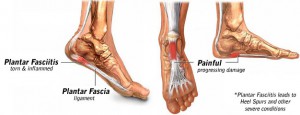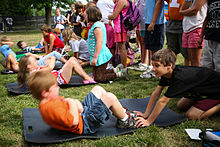
Heel pain and children don’t fit together very well. If heel pain flairs up, parents must be aware of how best to intervene. It may be plantar fasciitis which, if left on its own, could turn into a much more difficult foot issue as they age.
As children grow, their feet grow too. According to the website Heel That Pain, 8-10 year old girls and 10-12 year old boys who are physically active will more likely feel pain due to Sever’s Disease. At this age, while the heel is still developing, the back of the heel becomes inflamed due to pressure and subsequent micro-tears.
By the time the child has reached their teens, their heel is typically mature. Plantar fasciitis now becomes a greater risk factor.
Plantar Fasciitis in Children
Plantar fasciitis in a child is typically a problem of overuse, just as in adults. It will most likely be found in children who are athletes participating in team sports, in aerobics, dancers, skaters, or runners, those who use their feet a lot already and are susceptible to trying to do more than they are used to doing.
It can also easily affect a youngster who decides to participate in something that is way beyond their normal activity level.
An example is when a young person prepares for or runs a long race when they have not adequately and systematically prepared for the race through training and gradual build-up of their running distance.
Obviously, plantar fasciitis could also set in if the child walks a lot and wears shoes or sandals that are worn out or simply do not provide proper arch support. Be sure to check their footwear to make sure it isn’t the cause of the pain.
Typical Plantar Fasciitis Symptoms
The symptoms of plantar fasciitis will be the same with your child as those experienced by any adult, however, the child may not recognize these symptoms as quickly. If you are the parent of a child who complains about pain on the bottom of their heel, especially first thing in the morning, recognize that this is likely to be plantar fasciitis pain.
Here are a few additional signs of plantar fasciitis that you should watch for:
– The pain level goes down after your child has walked around a bit in the morning;
– Your child feels pain when they stretch their foot or when you press on the sides of the heel or the arch;
– There is more pain following the child’s activity than when they are actually doing it.
How to Handle the Child’s Pain
The good thing, as with adults, is that the pain will most likely subside and disappear if you help your child adjust their activity level. Don’t force them to “play through the pain” as many pro athletes do. Most importantly, make sure they rest their feet as much as possible.
Nonsteroidal anti-inflammatory drugs (NSAIDs) such as ibuprofen are safe and can help to reduce the pain and inflammation in the child’s heel.
Also, check their shoes to ensure that they are properly supporting the child’s foot. Several guidelines have been provided by the American College of Foot and Ankle Surgeons. These are:
– Throw out any shoes that cause pain. Do not use them for anything else;
– Well-built shoes, made for the particular sport, are best;
– Use inserts for the heel, particularly with flat-footed cleats;
– Cleats are not supportive footwear, so switch them often.
 In my experience, most children who participate in typical local sports leagues are not taught to “warm up” before playing their sport. Most volunteer coaches assume that the kids are in good shape and ready to play. If you help your child understand how to properly exercise their fascia, Achilles tendon, and calf muscles, you may help avoid foot and heel pain later.
In my experience, most children who participate in typical local sports leagues are not taught to “warm up” before playing their sport. Most volunteer coaches assume that the kids are in good shape and ready to play. If you help your child understand how to properly exercise their fascia, Achilles tendon, and calf muscles, you may help avoid foot and heel pain later.
If your child decides to participate in a long run or walk, activities that are common for fund-raising purposes, help them prepare. Show them how to develop a schedule of activity that starts slowly and increases the length and intensity of the activity over time. Make sure they have good shoes that will support this longer activity.
A Parent’s Responsibility
If the pain persists and continues to get worse over time, you should bring your child to the doctor. A doctor can look for other potential issues such as bone fractures or heel spurs. They may also assess whether the child has flat feet, high arches, or any other type of formative foot problem.
Take responsibility as a parent. Remember that by training children to understand foot and heel problems when they are young, you will benefit them the rest of their lives.
Has your child or someone else’s child that you know ever suffered with plantar fasciitis? How was it handled? Please share your thoughts or comments below.

Allyn, I enjoyed reading your article about Plantar Fasciitis in kids. Very interesting and informative. My DH has experienced the pain of this and its no fun at all. I would never want a child to have to deal with this, so thanks for the tips on preventing it. Shirley
Thanks for commenting, Shirley. You are absolutely right! Now that I’m aware of what it feels like, I know I don’t want my grandchildren to ever suffer with plantar fasciitis pain. Kids usually aren’t aware of what to do, so having parents who are informed is very important.
hi Allyn
good info for parents out there. I have had throbbing heel pain in the past and my former husband has plantar fasciitis so I know how painful it can be. Considering that kids handle pain differently, I would say that it is very important for parents to be vigilant and make sure there is no pain. Especially if the child is involved in sports. Using inserts could certainly be useful as well as “not playing through the pain” as you said.
Hi Emily. So, both you and your former husband understand that type of pain. It’s not something to let slide, for sure.
Lots of kids play in local sports leagues now and many are required to wear cleats. Cleats are just not very good as supportive shoes so those inserts may be very helpful. Kids usually tell us when things hurt but if parents don’t understand heel pain, they may not consider it to be on the same level as an “illness”, for example. Thanks for your thoughts.
Great site! I have a 6’9 15 year old who plays football, basketball and track. He has had heel pain and now I know what it is and how to treat it thanks for this site! great work.
Wow! He’s a very active athlete, June. I’m glad to know that my site was able to help you understand his pain better and also give some tips on what to do if it hits him again. Thanks for sharing.
By the way, come on back occasionally. I’ll be adding a lot more tips on preventative treatments and exercises.